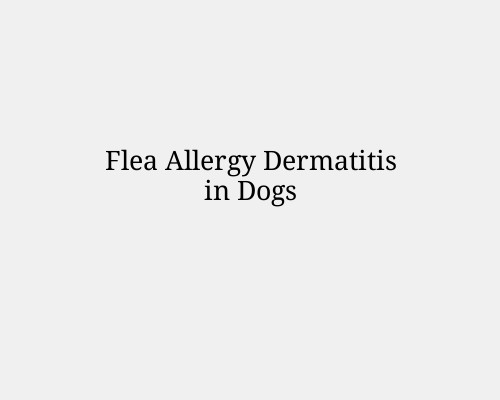Flea Allergy Dermatitis in Dogs
Flea Allergy Dermatitis in Dogs: Symptoms, Causes, and Treatment
Flea allergy dermatitis (FAD) is one of the most common skin conditions in dogs, caused by an allergic reaction to flea saliva. Even a single flea bite can trigger intense itching and discomfort, making early identification and treatment crucial for your dog's comfort and well-being. This article will guide you through the symptoms, causes, diagnosis, treatment, and prevention of flea allergy dermatitis in dogs.
What is Flea Allergy Dermatitis?
Flea allergy dermatitis is an allergic reaction that occurs when a dog is bitten by a flea. The proteins in flea saliva are highly allergenic to some dogs, leading to an overactive immune response. While all dogs can be affected by flea bites, dogs with FAD experience heightened symptoms compared to those without the allergy.
Common Symptoms of Flea Allergy Dermatitis
Recognizing the signs of flea allergy dermatitis early can help prevent the condition from worsening. The most common symptoms include:
Intense Itching and Scratching: Persistent scratching, biting, or licking at the skin, especially near the tail base.
Hair Loss: Patchy or widespread hair loss, often around the tail, lower back, and hind legs.
Red or Inflamed Skin: Irritated, reddened skin that may become swollen or warm to the touch.
Hot Spots: Moist, oozing lesions that develop as a result of constant scratching or licking.
Crusting and Scabbing: Scabs or crusty lesions may form on the affected areas.
Secondary Skin Infections: Open wounds can become infected, leading to pus, odor, and further irritation.
Causes of Flea Allergy Dermatitis
FAD is caused by a hypersensitive immune response to flea saliva. When a flea bites, it injects saliva that contains a mix of enzymes and proteins. Dogs with FAD react to even minimal exposure to flea saliva, making it possible for one or two flea bites to cause severe itching and inflammation.
Certain factors may increase the likelihood of developing FAD:
Age: Young or middle-aged dogs are more commonly affected.
Breed Predisposition: Some breeds, such as terriers and retrievers, may be more prone to skin allergies.
Seasonal Exposure: Flea activity tends to peak during warmer months, although fleas can survive year- round indoors.
How Flea Allergy Dermatitis is Diagnosed
Veterinarians typically diagnose FAD based on:
Clinical Signs: Observing symptoms like itching, hair loss, and hot spots.
Flea Dirt or Fleas: Finding fleas or flea dirt (black specks resembling pepper) on the dog’s coat.
Skin Scrapings: To rule out other conditions like mange or fungal infections.
Intradermal Allergy Testing: An advanced test to confirm flea allergy by injecting flea antigens under the skin.
Treatment Options for Flea Allergy Dermatitis
Effective treatment for FAD requires both managing the allergy and eradicating fleas. The following treatment strategies are commonly used:
Flea Control
Topical Flea Treatments: Spot-on treatments, such as fipronil or imidacloprid, are applied to the skin and kill fleas on contact.
Oral Flea Medications: Medications like afoxolaner and fluralaner kill fleas quickly and provide lasting protection.
Environmental Flea Control: Vacuuming carpets, washing bedding, and using flea sprays or foggers can eliminate fleas in the home.
Anti-Inflammatory Medications
Corticosteroids: Short-term use of steroids can reduce itching and inflammation. Antihistamines: Some dogs may benefit from antihistamines to manage mild itching.
Treating Secondary Infections
Antibiotics or Antifungals: If a secondary skin infection is present, antibiotics or antifungal medications may be necessary.
Soothing Topical Treatments
Medicated Shampoos: Shampoos containing ingredients like oatmeal, aloe vera, or chlorhexidine can soothe irritated skin.
Sprays and Creams: Anti-itch sprays or hydrocortisone creams may provide localized relief.
Preventing Flea Allergy Dermatitis
Prevention is key to managing FAD in dogs. Follow these steps to minimize flea exposure:
Year-Round Flea Prevention: Use veterinarian-recommended flea prevention products consistently, even during colder months.
Regular Grooming: Frequent brushing and bathing can help spot fleas early.
Home Environment: Vacuum regularly, wash pet bedding, and treat the yard with flea control products if necessary.
Multi-Pet Treatment: Ensure all pets in the household are treated for fleas to prevent re-infestation.
When to See a Veterinarian
If your dog shows signs of intense itching, hair loss, or skin irritation, consult a veterinarian promptly. Early intervention can help manage symptoms and prevent complications such as infections or chronic skin issues.
Conclusion
Flea allergy dermatitis can cause significant discomfort for dogs, but with prompt treatment and ongoing flea prevention, most dogs can live itch-free. By recognizing the symptoms, following your veterinarian’s recommendations, and staying proactive about flea control, you can help ensure your dog stays healthy and comfortable all year long.
Here’s a breakdown for a potential article on "The Role of Fleas in Canine Skin Allergies":
The Role of Fleas in Canine Skin Allergies
Introduction
Fleas are not just a nuisance; they can cause serious skin issues in dogs. Among the most common conditions is flea allergy dermatitis (FAD), an allergic reaction that occurs when a dog’s immune system overreacts to flea saliva. In this article, we’ll explore how fleas trigger allergies, what symptoms to watch for, and the best steps for prevention and treatment.
What Is Flea Allergy Dermatitis?
Flea allergy dermatitis is one of the most common skin conditions in dogs. When fleas bite, they inject saliva into the skin, which contains compounds that cause inflammation. Dogs with FAD are hypersensitive to these compounds, leading to intense itching and skin irritation.
How Fleas Trigger Allergic Reactions
Flea Saliva Allergens: The saliva contains over a dozen different substances that can cause allergic reactions in dogs.
Exaggerated Immune Response: A dog with FAD experiences an amplified immune response, even if only a few fleas are present.
Secondary Infections: Excessive scratching or biting at flea bites often leads to broken skin, opening the door for bacterial infections.
Signs and Symptoms of Flea Allergy Dermatitis
Dogs with flea allergies often show the following symptoms:
Intense Scratching: Persistent itching, especially around the base of the tail, groin, and thighs.
Red or Inflamed Skin: Look for redness, rashes, or hot spots in frequently scratched areas.
Hair Loss: Patchy bald spots, often near the tail, are common in cases of FAD.
Scabs or Crusting: Scabs or rough, flaky skin may form due to excessive licking or scratching.
Behavioral Changes: Dogs with FAD may appear restless or irritable due to constant discomfort.
Diagnosing Flea Allergies in Dogs
Veterinarians typically diagnose FAD based on clinical signs, flea history, and skin tests. In some cases, allergy testing or skin scrapings may be necessary to rule out other conditions like mange or bacterial infections.
Prevention and Treatment of Flea Allergy Dermatitis
Flea Control:
Year-Round Flea Prevention: Administering oral or topical flea preventatives can help eliminate the problem before it starts.
Environmental Control: Regularly vacuuming and washing bedding helps eliminate fleas and eggs in your dog’s environment.
Symptom Relief:
Anti-Itch Treatments: Your vet may recommend antihistamines, corticosteroids, or medicated shampoos to relieve itching.
Topical Soothing Agents: Aloe vera or oatmeal-based sprays can offer temporary relief for minor irritation.
Treating Secondary Infections:
Dogs with secondary bacterial infections may need antibiotics to fully heal.
Common Mistakes in Managing Flea Allergies
Delaying Treatment: Waiting too long to treat fleas or FAD can lead to more severe infections.
Inconsistent Flea Prevention: Skipping flea preventatives for even a short period can lead to reinfestation and further allergic reactions.
Ignoring Environmental Control: Treating your dog without addressing the surrounding environment can result in persistent flea problems.
When to See a Veterinarian
If your dog’s itching persists, or you notice signs of infection (such as pus, swelling, or odor), seek veterinary care immediately. Early intervention can prevent complications and provide much-needed relief for your dog.
Conclusion
Fleas play a significant role in canine skin allergies, particularly flea allergy dermatitis. By understanding the symptoms and taking proactive measures, you can keep your dog comfortable and prevent recurring allergic reactions. Consistent flea control and prompt veterinary care are essential to managing this common condition.







